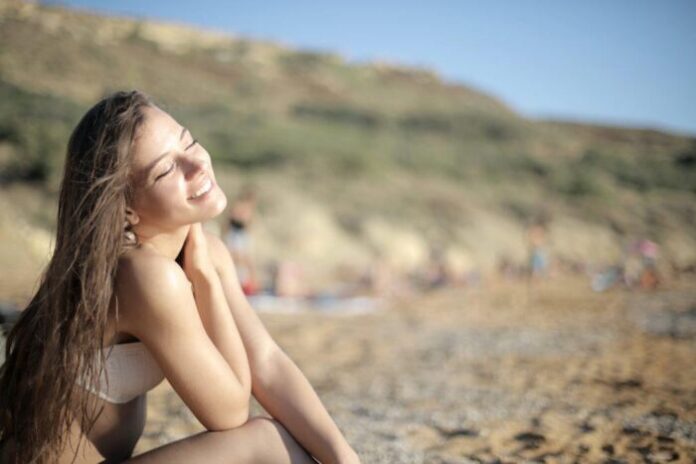
Even if spring seems to be late, in these days of temperature fluctuations, the rays of spring sun can be treacherous: lower temperatures than summer ones make the sun feel less direct, with the risk of getting burned.
In reality, the amount of solar radiation that reaches our latitudes in spring is very similar to that in summer with an aggravating circumstance: in this season the skin is poorly prepared and must be carefully protected, even if only for occasional exposure.
The city sun can betray and cause redness and erythema. Not to mention the effect of pollution, which, combined with that of the more intense UV rays, can cause real dermatitis. To protect yourself every day, a sunscreen with a Protection Factor of not less than 15 or 20 can be enough, applying it not only on the face, but also in the exposed areas and in particular in the more delicate ones, such as behind the knees, on the calves, on the instep and nape of the neck.
As for the most suitable formulation, fluid and less persistent textures than those used on the beach are fine. Hypoallergenic milks are perfect and enriched with antioxidant substances such as vitamin E and soothing ingredients such as herbal extracts of chamomile, rosehip and Aloe. As for the filters, they must be both against UVB, the rays that reach the surface and cause redness and burns, and against UVA, which instead penetrate deeper and are responsible for damage to skin cells.
To prepare the skin for the sun it is useful to do exfoliation. In this period, in the shower, it would be good practice to scrub twice a week or pass a bristle brush. Thus, when the skin is exposed to the sun, freed from the layer of dead cells, it will reach its maximum pigmentation within 6 days, compared to the 12 usually necessary, and will have a more even color. Exfoliation of the face should also be carefully performed with a gentle scrub or with a clay-based mask. Various fruit acids should not be used.
Sunlamps do not prepare the skin for sun exposure as the pigmentation given by sunlamps is only superficial and does not give the skin the same level of photoprotection that is obtained with the sun’s rays and therefore with tanning.
Self-tanning cosmetics give a complexion that is only superficial because it derives from the oxidation of the proteins of the stratum corneum, the outermost one, and does not serve as a screen for the sun’s rays. There are self-tans with sunscreens on the market that allow you to expose yourself to the sun and immediately have an amber color.
With the first sun the skin can become more impure, but it could also “stain”. The spots on the skin of the face are due to malfunctioning of the melanocytes, the cells that produce melanin, which is the substance that protects the epidermis from UV rays and which, when it appears evenly, gives our skin a uniform tan. When the melanocytes don’t work properly and the tan disappears, however, unsightly brown or gray spots may remain on the skin.
In addition to ultraviolet rays, genetic, hormonal or environmental factors also affect the appearance of spots on the face.
There are various types of sunspots that affect the face and the most common among the population are:
- Melasma or chloasma: this type of sun spots on the face appears in the form of brown or hazelnut-colored patches with an irregular shape, concentrated in particular in the area of the cheekbones, forehead and upper lip, but which can also occur on the décolleté and ears. This form of skin hyperpigmentation particularly affects women between the ages of 30 and 40 and appears above all when estrogen is used – such as the birth control pill – or in the case of hormonal alterations and pregnancy (for this reason melasma is also defined pregnancy mask);
- Solar or senile lentigo: these sun spots appear on the skin of the face, décolleté, back of the hands and, in general, the areas most exposed to sunlight. They usually appear after the age of 40 and tend to become more numerous with advancing age. They come in the form of brownish circular-shaped specks and are due to photo-aging of the skin and prolonged exposure to sunlight over the years.
The most effective natural remedies to eliminate sun-induced skin spots are:
- Lemon: it has many benefits for our beauty but, in this situation, it will be useful for lightening sunspots. Thanks to its whitening properties, if applied directly on the spots it will eliminate dead cells making the skin brighter and gradually lightening the spot. Just create a compress with a few drops of lemon and a few drops of rose water and apply it to the affected areas in the evening before going to sleep;
- Aloe vera: aloe vera gel is important to say goodbye to spots caused by incorrect exposure to the sun: constancy is essential to see a good result, but it will be enough to create compresses with this gel to gradually see the stain clear. Alternatively, it is possible to massage the aloe juice on the affected areas for a couple of times a day, for at least 20 minutes;
- Gentian: a decoction of gentian is a good remedy for skin spots; in herbal medicine you can find dried gentian root. To prepare the decoction it will be sufficient to pour a teaspoon of gentian root in a cup of boiling water leaving it to infuse before filtering it. Once cooled, it will be possible to apply it in critical points and the spots will gradually lighten;
- Essential oils: if, as often happens, unfortunately, you can’t find time to make a pack, you can add carrot essential oil and celery essential oil to your daily moisturizer: just a drop applied daily will suffice. to prevent sunspots from becoming more noticeable;
- The lightening mask with yogurt and oats: a DIY facial mask is also useful to lighten sun spots that have appeared on the face. Pour 6 tablespoons of oatmeal, 5 tablespoons of apple cider vinegar, 2 of aloe vera gel and a few drops of lemon juice into a jar of plain yogurt. Mix everything and apply the mixture on the face, leaving it to act 15 minutes before rinsing with warm water.
Prevention, as always, will allow us to avoid annoying skin imperfections such as spots on the skin. During spring and summer, first of all, it is a must to apply the sunscreen on the face at least half an hour before sun exposure: it is advisable to choose a cosmetic with a medium-high protection factor and with moisturizing agents, in order to combine protection and hydration, and without perfume. On the face it would be advisable to use a moisturizer with a medium protection factor even during the winter.
In addition to creams, it is possible to use food supplements that contain zinc, selenium, Vitamins ACE and beta-carotene. A healthy diet can be a panacea: water, fruit and vegetables are essential especially in summer while fatty foods, caffeine, alcohol and nicotine must be avoided.






































